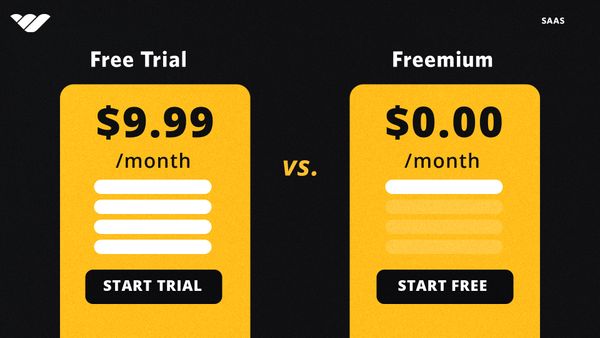Are you a SaaS business trying to figure out the best way to attract and convert new customers? If so, you're not alone. You know that teasing your customers with something free is the best way to bring them into your ecosystem and - hopefully - earn a lifelong customer.
But with so many different pricing models available, it can be tough to know which one will work best for your business.
The good news? We’re here to help. In this blog post, we'll compare two popular pricing models for SaaS businesses: free trials vs freemiums. Both models offer customers a chance to try out your product before committing to a purchase, but they have some key differences.
By the end of this post, you'll have a better understanding of the pros and cons of each model, and you'll be able to make an informed decision about which one is right for your business. We'll look at factors like cost, conversion rates, and customer lifetime value to help you evaluate the best option. So if you're ready to learn more about how to attract and convert more customers for your SaaS business, keep reading!
What is the Difference Between Freemium vs Free Trial?
Before we can compare and contrast the freemium vs free trial directly, we need to fully explain what each of these models is and what they entail. Let’s start by breaking down freemiums.
What is a Freemium?
A freemium model is where the basic version of the software is offered for free, but premium features or advanced functionality are only available to paying customers. This means that users can use the software indefinitely without paying, but they may be limited in the number of features or capabilities that they can access.
Freemium models are popular because they allow users to try out the software before committing to a purchase, and can help businesses build a large user base. However, it can be challenging to convert free users to paying customers, and businesses need to carefully balance the value of the free features with the revenue generated by the premium features.
We’ll talk more about this later on. First, let’s introduce the other half of this conversation: the free trial model.
What is a Free Trial?
A free trial, on the other hand, is a time-limited offer that allows users to access the full range of features of the software for a set period, typically anywhere from a few days to a month.
Free trials are often used to give potential customers a chance to experience the full value of the software before committing to a purchase. They can be an effective way to convert leads into paying customers, as users are more likely to see the value in the software if they have had a chance to use it extensively.
However, free trials can be expensive to offer, as businesses need to invest in infrastructure to support a large number of trial users, and may need to offer customer support and training during the trial period. Moreover, there’s no guarantee that members on a free trial will ultimately commit to a paid version of your software once their trial period is up.
Free Trial vs Freemium: Which Model is Best for Your Business?
Free trials and freemiums are similar in that they seek to capture the interest of prospective customers by offering a small taste of what your software is all about. The end goal of both of these models is to convert them into paying customers.
However, that is where the similarities end in the free trial vs freemium debate. Only one of these models is right for your company - and below, will help you figure out exactly which that is.
Pros & Cons of a Freemium Model
Pros:
- Attracts a large number of users due to the availability of a free version.
- Users have the chance to test out the product and decide if they want to upgrade.
- Can increase brand awareness and lead generation.
- Customers who use the premium version may be more loyal and have a higher lifetime value.
Cons:
- It can be difficult to convert free users to paying customers. If they get enough value out of the freemium tier, why would they pay for more?
- Offering a free version can be costly to maintain and may not generate enough revenue.
- There is a risk of cannibalizing your premium users with the free version. While many users would be willing to pay for the service, if they see it’s free, they may opt for that instead.
- It can be challenging to find the right balance between free and premium features. You want to give enough to hook the user in without giving them so much that they don’t need to pay for advanced features.
Pros & Cons of a Free Trial
Pros:
- Allows potential customers to test out the full product before committing to a purchase.
- Higher likelihood of converting trial users to paying customers.
- Can provide valuable feedback on the product and help with product development.
- Can lead to increased customer satisfaction and loyalty.
Cons:
- Offering a free trial can be expensive in terms of infrastructure and support.
- It can be challenging to determine the optimal length of the free trial.
- Customers may not have enough time during the trial period to fully evaluate the product.
- The free trial may attract users who are not serious about buying the product. They subscribe to get what they need and then leave - or worse, create another free trial under a different email/account.
Consider Your Strategy for Going to Market: Dominant, Disruptive, or Differentiated
The choice between a freemium model and a free trial for a SaaS company ultimately depends on the company's go-to-market strategy. Chances are, your business falls into one of these three buckets: dominant, disruptive, or differentiated.
A dominant go-to-market strategy typically involves a well-established brand with a large customer base and a focus on maintaining market share. For companies with a dominant go-to-market strategy, a freemium model may be more appropriate as it allows them to maintain market share while still generating revenue from premium users.
For example, Dropbox offers a freemium model that allows users to store a certain amount of data for free while charging for additional storage. This model allows Dropbox to maintain its dominant position in the cloud storage market while still generating revenue from premium users.
A disruptive go-to-market strategy typically involves a new entrant in the market with a focus on capturing market share from incumbents. For companies with a disruptive go-to-market strategy, a free trial may be more appropriate as it allows them to quickly demonstrate the value of their product to potential customers. For example, Slack offered a free trial when it first launched to quickly gain traction and capture market share in the team collaboration market.
A differentiation go-to-market strategy typically involves a focus on a specific niche or unique value proposition. For companies with a differentiation go-to-market strategy, both freemium and free trial models may be appropriate depending on the specifics of the company's value proposition.
For example, a company with a unique and complex software product may benefit from a free trial that allows potential customers to fully evaluate the product before committing to a purchase, while a company with a simpler product may benefit more from a freemium model that allows users to test out the basic features before upgrading to premium.
The Verdict: Which is Right For You?
Now - with all that said, which is the right approach for your company: freemium vs free trial? Ultimately, this is something you’ll have to answer yourself based on the factors we’ve discussed above. There is no “right” or “wrong” answer.
However, there are a few key takeaways we want to leave you with:
- Differentiated companies are best suited to a free trial approach
- Disruptive companies are best suited to a freemium approach
- Dominant companies can ultimately choose between both freemium and free trial models with a high rate of success.
The Free Trial vs Freemium Debate
Hopefully, this in-depth guide to the free trial vs freemium debate helped you gain clarity as to which approach is best for your company. Choosing the right model for your business is key to acquiring and retaining new customers - and getting them to pay for your software.
👉 To improve your reach, get your SaaS listed at Whop - making it easy to scale your project and get your business in front of new eyes.



![The Best SaaS Subscription Management Software [2024]](/blog/content/images/size/w600/2023/11/SaaS-management.webp)

